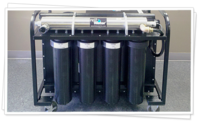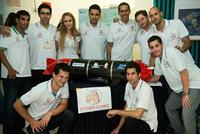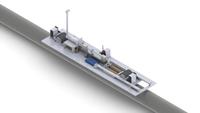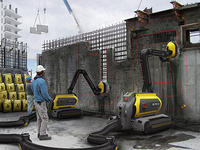-
UMaine student develops affordable option for shoring up Maine’s aging bridges

The State of Maine Department of Transportation is responsible for 2,772, or 70 percent, of the bridges in the state. A 2007 report found that of those bridges, 205 are more than 80 years old, 244 were considered in poor condition, and 213 were found to be structurally deficient. Additionally, 288 bridges were at risk of closure or weight restrictions between 2007 and 2017. Replacing all these bridges would be too costly. Researchers developed software designed specifically to assess the load rating of flat-slab bridges to determine which bridges can be repaired instead of replaced. For the bridges that can last a few more years with reinforcing instead of replacing, the researchers engineered a retrofitting system which could be applied to increase the bridge’s strength and weight limits.
-
-
Water purifier for soldiers, first responders successfully tested in the field

A new easy-to-carry water purifier that could give Marines and first-responders access to clean water wherever they go successfully completed its first operational test. The new purifier was developed to help reduce enormous logistical burdens already faced by forward-deployed personnel. There are two versions — one that can treat 1,000 gallons per day and one that can handle 5,000 gallons per day.
-
-
Making power lines safer
Last year, blackouts left 620 million people in India without power for a couple of days, and cost the U.S. economy more than $120 billion. Electric sparking has been blamed for major bushfires in Australia. Researchers have invented and patented a way of detecting and locating potential electrical faults along long stretches of power line before they occur.
-
-
New underwater robots mimic designs found in nature
In recent years, robotic underwater vehicles have become more common in a variety of industrial and civil sectors. Now, a new class of underwater robot has emerged that mimics designs found in nature. These “biomimetic” vehicles promise to lead to new underwater technologies that could help the oil and gas industry, underwater humanitarian demining, environmental monitoring, search and rescue operations, anti-terrorist activities, harbor surveillance, coastal security and fisheries management, and more.
-
-
Young engineers compete in underwater robotics race
Student-built autonomous underwater vehicles will speed through the depths of a Navy pool in a battle for supremacy at the 16th International RoboSub Competition. The competition is being held this week (22-28 July). In addition to building autonomous underwater vehicles, teams are also responsible for creating Web sites and writing journal papers that outline their work.
-
-
Ben-Gurion University student team’s Hydro Camel competes in RoboSub Competition

Today, there are many remotely operated submarines that handle important tasks, such as checking underwater pipelines, mapping underwater minefields, searching for locations to place communication cables, and searching for sunken vessels. These marine vessels, however, are limited by effective communication cables and require frequent human-operator contact. Ben-Gurion University of the Negev is developing a more accurate and effective autonomous, independently thinking underwater vessel that would revolutionize these and other tasks. The BGU entry in the RoboSub Competition is called Hydro Camel.
-
-
Hollow-core optical fiber to enable high-power military sensors
The intensity of light that propagates through glass optical fiber is fundamentally limited by the glass itself. A novel fiber design using a hollow, air-filled core removes this limitation and significantly improves performance by forcing light to travel through channels of air, instead of the glass around it. DARPA’s spider-web-like, hollow-core fiber design is the first to demonstrate single-spatial-mode, low-loss and polarization control — key properties needed for advanced military applications such as high-precision fiber optic gyroscopes for inertial navigation.
-
-
Georgia Tech’s VentureLab ranks No. 2 among university-based incubators
Georgia Tech’s VentureLab helps create startup companies based on Georgia Tech research. Since its formation in 2001, VentureLab has launched more than 150 technology companies which have attracted more than $700 million in outside funding. VentureLab program has been ranked second in the world in a new benchmarking study. The study, conducted by UBI Index, examined 150 university-based business incubators in twenty-two different countries.
-
-
U.S. research universities subject to sustained cyberattack campaign by China
Leading U.S. research universities report that they have been subject to millions of Chinese hacking attempts weekly. The Chinese are aware that universities, and the professors who do research under the schools’ auspices, receive thousands of patents each year in areas such as prescription drugs, computer chips, fuel cells, aircraft, medical devices, food production, and more. The Chinese government-sponsored cyberattacks on American research universities are an expansion of efforts by China to steal information that has commercial, political, or national security value.
-
-
CIA copied, employed “Q”-developed 007 outlandish gadgets

The real-life CIA copied and employed a few outlandish gadgets from James Bond movies. The CIA was successful copying Rosa Klebb’s infamous spring-loaded poison knife shoe from the film From Russia with Love, but was less successful trying to copy the homing beacon device used in Goldfinger to track the villain’s car. The CIA version had “too many bugs in it,” former CIA director Allen Dulles would later say, and stopped working when the enemy entered a crowded city.
-
-
Crawling robot examines, evaluates condition of load-bearing cables

Severe weather events inflict damage and destruction. The condition of infrastructure and its components may contribute to the overall damage: weak components and damaged elements make infrastructure less likely to withstand the stress of a storm. Researchers have developed a crawling robot capable of examining and evaluating the condition of load-bearing cables, such as those found in bridges, elevators, and cable cars.
-
-
Concrete recycling robot disassembles concrete structures for recycling, reuse

Current concrete-demolition techniques require a lot of power crushing, separation, and machinery, not to mention the fact that they waste a lot of water in order to prevent dust blooms during operation. A new concrete recycling robot is designed efficiently to disassemble concrete structures without any waste, dust, or separation and enable reclaimed building materials to be reused for new prefabricated concrete buildings. It does so by using a water jet to crack the concrete surface, separate the waste, and package the cleaned, dust-free material.
-
-
Highly portable X-ray imaging system developed
Los Alamos National Laboratory and Tribogenics have developed the MiniMAX (Miniature, Mobile, Agile, X-ray) camera to provide real-time inspection of sealed containers and facilities.MiniMAX is an alternative to the large, expensive, and fixed facilities presently required for security inspections using X-ray imaging. The complete MiniMAX portable radiography system weighs less than five pounds.
-
-
Earthquake-proofing precast buildings
Precast or ready-made building structures offer a number of advantages when compared to more traditional construction techniques in terms of time and cost savings. The vulnerability of joints and connections between assembled precast elements, however, is widely recognized as a potential safety issue, especially in earthquake-prone areas. An EU-funded project has set out to develop new procedures and guidelines for designing precast structure joints and connections that can stand up to seismic forces.
-
-
Remote-controlled cockroaches to help in search-and-rescue missions
Researchers are using video game technology to remotely control cockroaches on autopilot, with a computer steering the cockroach through a controlled environment. The researchers are using the technology to track how roaches respond to the remote control, with the goal of developing ways that roaches on autopilot can be used to map dynamic environments — such as collapsed buildings.
-
More headlines
The long view
New Technology is Keeping the Skies Safe
DHS S&T Baggage, Cargo, and People Screening (BCP) Program develops state-of-the-art screening solutions to help secure airspace, communities, and borders
Factories First: Winning the Drone War Before It Starts
Wars are won by factories before they are won on the battlefield,Martin C. Feldmann writes, noting that the United States lacks the manufacturing depth for the coming drone age. Rectifying this situation “will take far more than procurement tweaks,” Feldmann writes. “It demands a national-level, wartime-scale industrial mobilization.”
How Artificial General Intelligence Could Affect the Rise and Fall of Nations
Visions for potential AGI futures: A new report from RAND aims to stimulate thinking among policymakers about possible impacts of the development of artificial general intelligence (AGI) on geopolitics and the world order.
Keeping the Lights on with Nuclear Waste: Radiochemistry Transforms Nuclear Waste into Strategic Materials
How UNLV radiochemistry is pioneering the future of energy in the Southwest by salvaging strategic materials from nuclear dumps –and making it safe.
Model Predicts Long-Term Effects of Nuclear Waste on Underground Disposal Systems
The simulations matched results from an underground lab experiment in Switzerland, suggesting modeling could be used to validate the safety of nuclear disposal sites.
